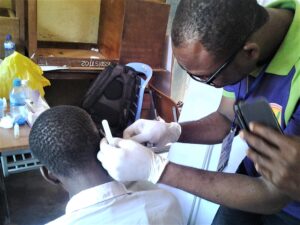By Sadiku Olubusayo O.
Save the Deaf and Endangered Language Initiative (SDELI)
Tonye is a happy 10-year-old boy. He was born at a primary health care center close to his home, hale and healthy. At the age of two, his mother noticed he stopped responding to sounds. She noticed this some weeks after an immunization shot, he had taken and concluded that was the cause of his deafness. Like her, S-DELI (Save the Deaf and Endangered Languages Initiative) has met with many parents of the deaf who attributed their wards deafness to vaccines and use of antibiotics. What are the facts about the causes of hearing loss/deafness? This article focuses on some causes of impaired hearing in children in Nigeria and describes such from a medical point of view.
Let us do a bit of anatomy to understand how the ear functions. The ear is divided into three sections:
- The outer ear- This is the external part we see, and it directs sound waves into the ear canal.
- The middle ear- This is an air-filled space, and sound waves reaching here cause vibrations that are amplified by the small bones of the middle ear and are then transmitted into a round window that connects the middle ear to the inner ear.
- The inner ear- This is a fluid filled space consisting of the cochlea (for hearing) and the vestibular system (for balance).
While these three sections are involved in hearing, the inner ear is responsible for hearing. The cochlea has a structure that contains thousands of specialized sensory hair cells, thus, when vibrations are transmitted from the middle ear, the vibration is felt by the inner fluid filled space. The hair cells vibrate in turn, and then convert the vibrations into signals (transported by nerves to the brain) that the brain interprets as sound.
When a person is deaf, the person is unable to hear sounds, indicating a derangement in one, or more of the processes of hearing explained above. In children, hearing loss could be congenital (from birth) or acquired. The common causes of hearing loss in children include, genetics (hereditary), certain medications, passive smoking, certain diseases and exposure to loud noises.
Some forms of hearing loss are genetic. Alteration in any of the genes responsible for hearing could result in hearing loss or deafness. Even if parents to a deaf child are hearing, they could both carry a recessive altered gene that manifests in the child, resulting in deafness. Otosclerosis is another inherited disorder. It affects the small bones of the middle ear (responsible for amplifying sound waves), thereby causing hearing loss.
Exposure of expectant mothers to poisons and toxic chemicals could affect neurodevelopment of the fetus causing impairment in the auditory pathway. Children who suffer from congenital viral infections are at greater risk of hearing loss. If a mother is infected with say, the German measles or rubella, her child is at risk of becoming infected with the congenital form of the virus and this could result in hearing loss 6 to 12months after birth. At birth, birth injuries, prematurity, prolonged labor, head injuries could result in hearing impairment or deafness. Birth trauma can cause damage in the hearing pathway between the inner ear and the brain. Anoxia, oxygen deprivation can cause damage to the sensory cells of the inner ear. More so, some infections such as measles (rubeola), smallpox, chicken pox, mumps, viral and bacterial meningitis can cause hearing impairment. The high fevers that come with these infections can affect the brain or the part of the brain responsible for interpreting sound.
Certain medicines, when taken in high doses by certain persons, can damage structures in the inner ear. Noise is also a potential cause of hearing loss. Hearing loud noises over a long period of time or hearing sudden loud noises can also damage structures of the inner ear. Recurrent/untreated infection of the middle ear can damage the small bones of the middle ear leading to permanent hearing loss.
In conclusion, while some of these causes lead to permanent hearing loss, many are preventable. Knowing the possible causes of deafness, particularly preventable causes, can help in reducing the prevalence of deafness in children. So, as a parent or parent to be, it is important to get informed so we can play our part in reducing hearing loss to the barest minimum.
*The name(s) in this article are fictitious for the purpose of protecting the identity of the individual(s) about whom the article is written.

References
Nwadinobi V.N. 2019. Hearing impairment. https://www.researchgate.net/publication/336025368.
Okeke, B.A (2001). Essentials of Special Education Nsukka, Afro Orbis publication Ltd.
https://www.signia-hearing.com/blog/what-you-need-to-know-about-sudden-sensorineural-hearing-loss

